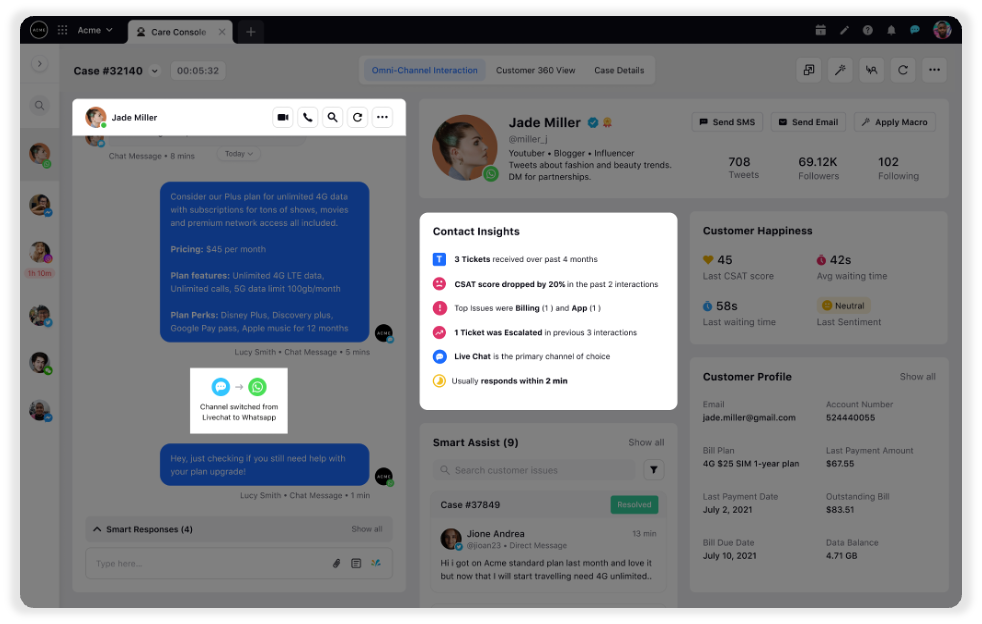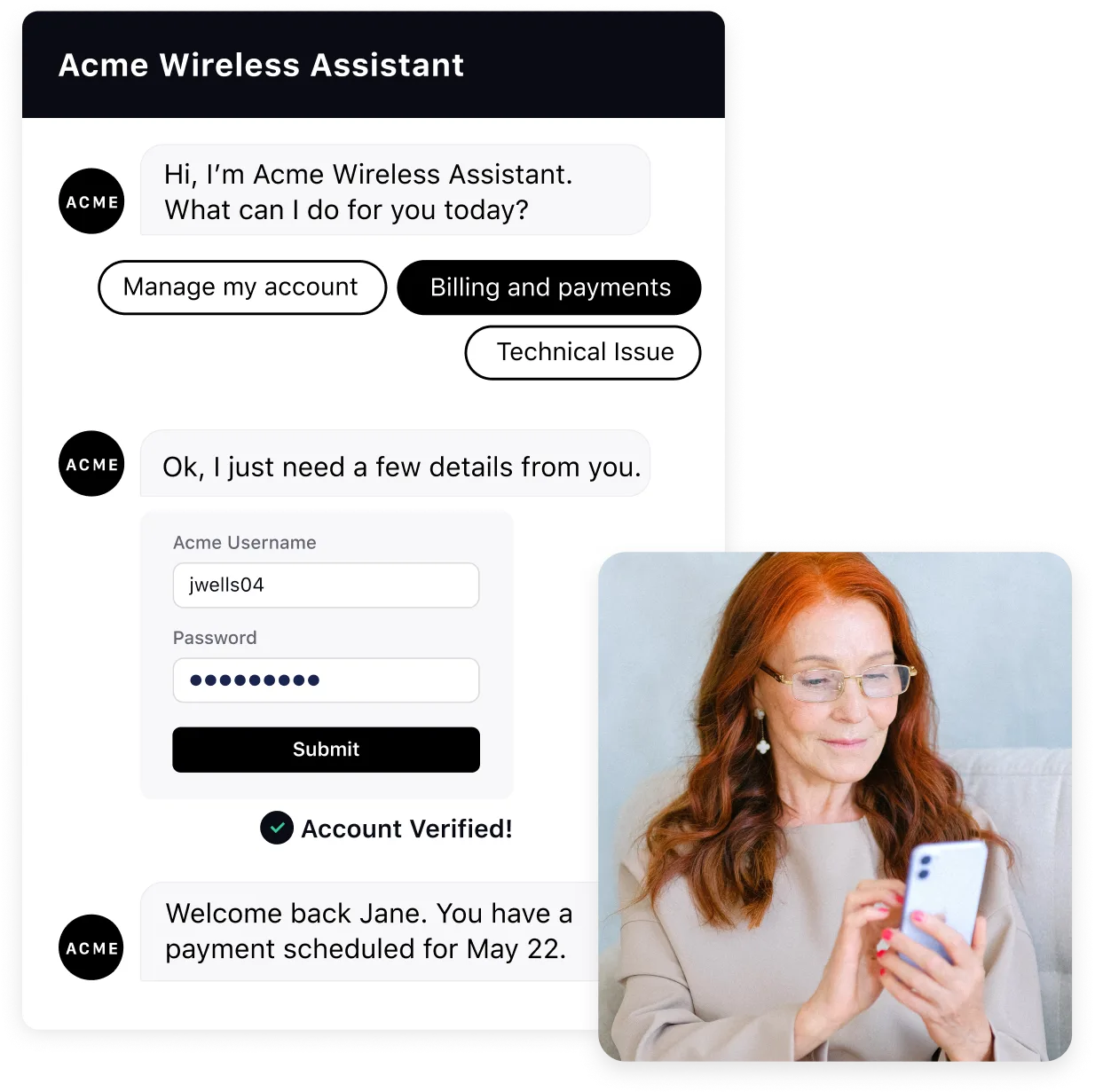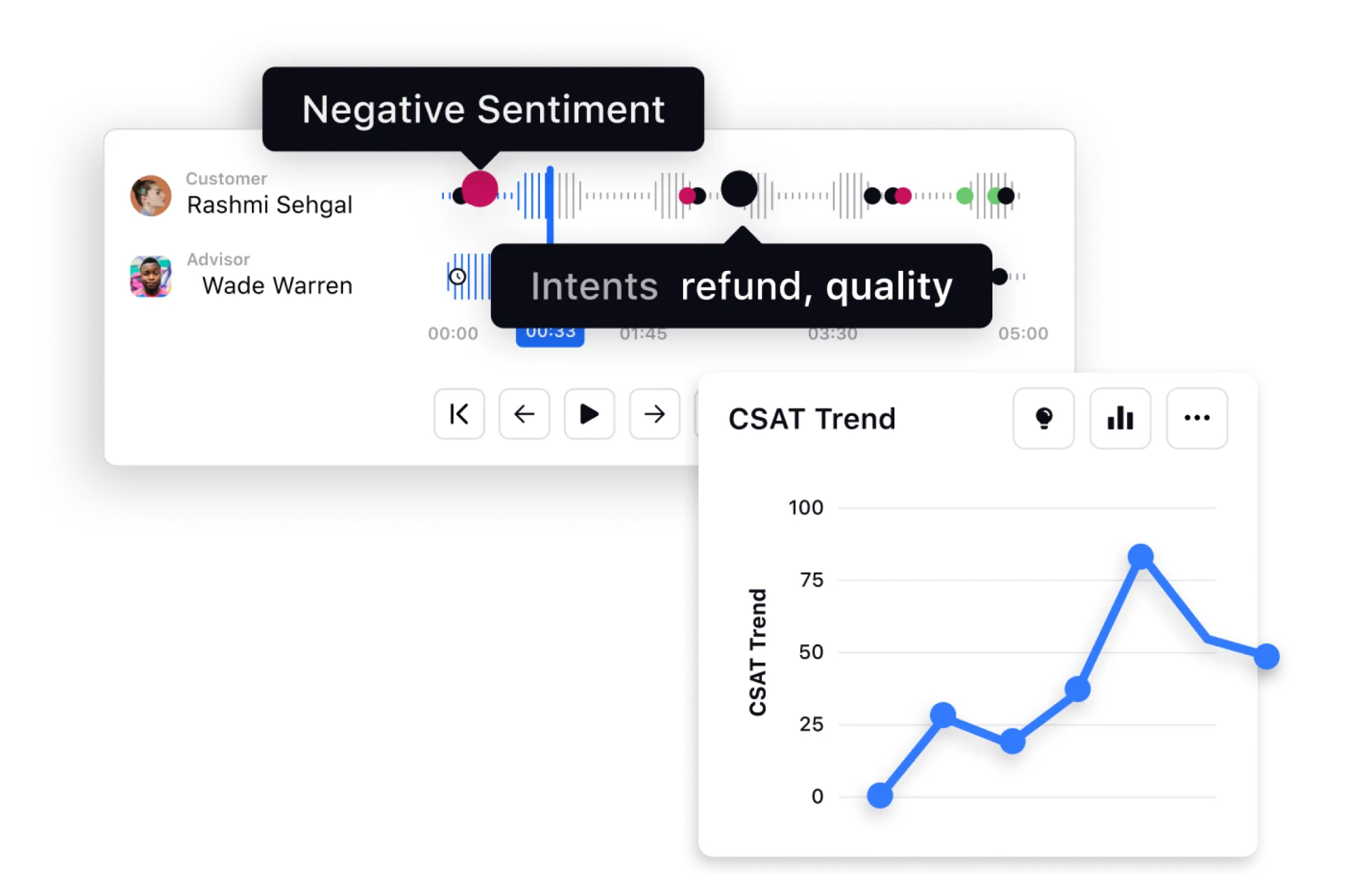- What is an inbound contact center?
- Examples of inbound contact center
- Outbound contact center vs. inbound contact center
- What are the channels used by inbound contact centers?
- Key benefits of inbound contact centers
- Top 6 features of inbound contact centers
- Inbound contact center best practices
- Scale and streamline your inbound contact center services with Sprinklr
What is an inbound contact center?
An inbound contact center handles incoming calls, SMS, emails, chats and social media messages from both customers and prospects. Customers typically reach out when they require technical support, while prospects inquire about your business and offerings.
In most businesses, inbound contact centers operate within the customer service or support department. Their primary objective is to ensure timely customer assistance and swift resolution of issues.
The role of the inbound contact center is critical to your business’s long-term success as it directly impacts customer satisfaction and customer retention rate. Here is a detailed guide to help you harness the full potential of an inbound contact center and create positive customer experiences for your business.
Examples of inbound contact center
There are different ways of categorizing inbound contact centers. They can be grouped by:
Function
Tech support
Customers often face issues with product or service usage, installation, malfunctions and more. Inbound contact centers specialized in tech support promptly offer assistance in these domains while taking into account customer expectations and operational feasibility.
Useful for: Fast Moving Consumer Durables (FMCD), heavy electrical and automobile companies leverage inbound contact centers to ensure easy accessibility for customers and offer personalized support.
Order and payment
Online shoppers frequently encounter issues related to order, payment, exchange, delivery, refund and more. Inbound contact center agents utilize CRM systems to retrieve customer data and troubleshoot problems.
Useful for: The eCommerce sector, any business with an online presence today relies on inbound contact centers wherein the agents assist customers with purchase and billing-related issues daily.
Subscription purchase, renewal and cancellation
In today’s subscription economy, customers can purchase, renew, cancel and escalate experience-related concerns anytime, anywhere.
Useful for: Leading Over-The-Top (OTT) platforms, digital products and services reach out to subscription providers over voice and digital channels. The businesses address customer queries through inbound contact centers. Since subscription-based services are primarily experience-driven, inbound contact centers are critical in retaining subscribers.
24x7 Helpdesk
Inbound contact centers providing 24x7 helpdesk services play a crucial role, especially when customers and prospects seek information and awareness.
Useful for: Government agencies and non-profit organizations, the inbound contact centers ensure that you have access to relevant information around the clock.
Customer-centric businesses and socially responsible organizations also establish inbound contact centers to raise awareness about various social issues.
Read more: Helpdesk software and its benefits
Location
Onshore
An onshore inbound contact center is in the same country as your customers. Onshore inbound contact centers offer cultural familiarity, language alignment and operate in the same time zones as your customers. So it’s easier for you to connect and communicate with your customers, enhancing the overall service experience.
Offshore
An offshore contact center operates from a country different from where your customers are located. Often chosen due to lower labor costs, inbound contact centers with offshore operations may encounter challenges related to language differences, cultural nuances, and time zone disparities.
Cloud
Cloud-based contact centers are hosted and managed on remote servers and accessible through the Internet. Cloud-based inbound contact centers are increasingly gaining popularity because of their greater scalability, flexibility, and cost-effectiveness.
Channel adaptation
Multichannel
Here, the inbound contact centers utilize various communication channels to interact with customers. Each channel operates independently, allowing customers to reach out through their preferred medium, such as phone calls, emails, live chat, or social media. While multichannel contact centers offer multiple communication options, they might lack seamless channel integration, potentially leading to fragmented customer experiences.
Omnichannel
Omnichannel contact centers take customer interaction to the next level by seamlessly integrating all communication channels. Customer data and interactions are centralized, enabling agents to access a holistic view of each customer's journey across various touchpoints.
The result is a personalized, consistent customer experience, allowing effortless channel transitions for customers and agents without repetitive explanations.
Outbound contact center vs. inbound contact center
Both inbound and outbound contact centers have their own unique functions and purpose. While the nature of the interaction is the key differentiator between them, here are other differences you should know.
Objective
Outbound contact center agents are not responsible for fielding incoming customer calls; they concentrate on driving sales, generating leads and providing proactive services. Key functions of an outbound contact center include
Making proactive customer service calls and messages
Appointment setting
Telesales/telemarketing
On the other hand, inbound contact center agents focus on customer service, diligently working to create favorable customer experiences by efficiently managing calls and swiftly resolving issues.
The primary functions of an inbound contact center are:
Answering customer service calls
Fielding sales queries
Troubleshooting product usage issues
Assisting callers with 24X7 help desk
Tools
In outbound contact centers, tools like auto-dialer are crucial as they reduce the time agents spend on the manual dialing process, allowing them to focus more on engaging with potential customers and delivering a personalized sales pitch.
However, in inbound contact centers, efficient call routing and call deflection are paramount. Directing calls to suitable agents based on their availability and skills enhances your service standard. Likewise, deflecting voice calls to more cost-effective channels like WhatsApp or live chat helps keep your costs down.
Key Performance Indicators (KPIs)
In outbound contact centers, supervisors prioritize KPIs such as connection rate, lead conversion rate, speed to lead, and cost per acquisition.
In contrast, in inbound contact centers, you can measure the following KPIs to reflect efficiency:
average hold time
Learn more: Power your contact center with the right KPIs
What are the channels used by inbound contact centers?
Customers use various modern channels to get in touch with the companies they do business with. Companies must adapt to this behavior with a CCaaS platform.
Some of the most common channels for inbound communication are:
Phone calls: Even as customers adopt multichannel support, phone calls remain a vital touchpoint to seek customer service and company or product information.
Social channels: Today, social media platforms like Facebook, Instagram, and Twitter are becoming the favorite customer support channels among users due to their unmatched penetration and ease of use.
Messaging apps/platforms: Modern messaging platforms like WhatsApp and Telegram enable businesses to establish one-to-one connections with their customers. As these platforms have a broad user base, companies can quickly get customers to adopt them for their support needs.
Interesting read: A detailed guide on WhatsApp for customer service
Live chat: You can deploy a live chat app on your company's app or website, giving users an easy-to-use platform to voice their concerns or queries anytime.
Email: Emails allows customers to compose messages at their own pace and attach relevant documentation while communicating complex issues or inquiries. Since it allows for a threaded conversation, your support agents have a documented history of their interactions, leading to efficient and accurate resolution of issues.
Key benefits of inbound contact centers
Inbound contact centers offer myriad benefits to brands, from enhanced customer experience to lower costs of service. Let’s explore them in detail.
It differentiates your brand from the rest
In an era where product differentiation is challenging, the service standard differentiates you from your competition. A well-equipped inbound contact center with trained agents can help you build empathetic conversation, resolve issues faster and deliver memorable customer experiences at scale.
Customers pay a premium for efficient customer service
An above-average product with top-notch service is better than a good product with lackluster customer service. Customers tend to stick with brands that value them and offer prompt service as and when requested.
Moreover, an improved service standard driven by your inbound contact center enhances customer loyalty, increases retention rate and helps you set the stage for upselling and cross-selling opportunities.
It helps you build a positive brand perception
Prioritizing customer issues and offering timely service influences word-of-mouth promotion and improves your net promoter score (NPS). Therefore, investing in your inbound contact centers and aligning their operations with your mission and values can serve as a strategic branding move that helps you build a niche for yourself.
Top 6 features of inbound contact centers
Running inbound contact centers is not easy. However, by leveraging the key inbound contact center features, you can deliver positive customer service consistently and at scale.
If you are evaluating an inbound contact center solution, you must seek the following features.
1. Automatic call distribution
As the call volume in your inbound contact center increases, Automatic Call Distribution (ACD) helps you route calls to suitable agents based on predefined information and agent availability. It also forms the basis for skill-based routing and call monitoring so that you stay on top of your daily inbound contact center operations.

2. Interactive Voice Response (IVR)
The role of IVR is critical in your inbound contact center operations. By guiding callers through a sequence of prompts, IVR identifies their intentions and challenges, directing them to the relevant department. IVR keeps callers engaged and ensures they reach the correct destination for quicker issue resolution.

3. CRM integration
The role of CRM in an inbound contact center is to centralize and manage customer interactions, providing agents with valuable insights into customer history, preferences and issues. CRM systems help streamline customer information, enabling personalized interactions and facilitating efficient issue resolution.
Pro tip: Today, you can give your agents a complete view of the customer by capturing all details in a unified agent console so that they focus more on conversations and less on data.

4. Virtual agents
Your customers expect assistance round the clock and using agent unavailability during after-hours as an excuse is no longer acceptable. Integrating a chatbot or voice bot into your inbound contact center becomes essential since it can handle FAQs and automate routine tasks outside regular working hours, ensuring continuous customer support.

5. Real-time analytics
Measuring the critical inbound contact center metrics such as average hold time, call abandonment rate and average handling time in real-time is crucial since it helps you strategize your customer service operations and make more informed decisions.

Real-time analytics also helps you to track your inbound contact center performance against KPIs and SLAs.
Curious to learn more? Contact center analytics: A comprehensive guide
6. Granular reporting
The historical reporting feature in an inbound contact center helps supervisors have access to comprehensive performance metrics so they can make data-driven decisions. With historical reporting, inbound contact center managers can analyze the performance of each agent, department, virtual number and team.
Inbound contact center best practices
Customers reach out to businesses through inbound contact centers under different circumstances. Sometimes, service outage, product recall and natural disasters can cause a spike in inbound call volume. In light of this, here are the three best practices you should consider implementing in your inbound contact center.
1. Prioritize customer experience at any cost
With rising competition, customers will not stay only based on product and price. You must consider customer experience an integral part of your business model.
From offering proactive customer support to deploying customer self-service, you must instill a customer-centric culture across all your departments.
2. Focus on agent happiness
Equipping agents with the right tools and fostering an agent-friendly culture can yield remarkable results.
For example, the agent scorecard quantifies and measures various performance metrics, such as call resolution times, customer satisfaction ratings, and adherence to scripts, and provides agents with clear insights into their strengths and areas for improvement.

Additionally, gamification and rewarding agents for their exceptional performance significantly enhance agent morale and cultivate a positive attitude toward their work, often perceived as monotonous and exhausting.
Empowered agents remain emotionally connected to the company and as an owner of an inbound contact center, you stand to gain substantial benefits from their commitment.
Must read: How to manage call-center stress and become a happier agent
3. Keep an eye on KPIs
Running an inbound contact center can be overwhelming as you get exposed to hundreds of data points daily and are expected to act on them. So, you must evaluate the top inbound contact center metrics you must pay attention to. The ones you choose should include operational (answer rates, handle times etc.) and customer-experience-related KPIs (NPS, CSAT, CES etc.).
4. Invest in workforce management
Since inbound contact center solutions consistently face challenges such as traffic spikes, agent churn, and staffing issues, workforce management is pivotal for hassle-free operations.
Workforce management assists in creating a positive agent experience by ensuring fair workloads, manageable schedules, and well-planned breaks. This fosters agent retention, as empowered and satisfied agents, are more likely to stay, helping you maintain consistent service levels.
Now that you have a fair understanding of inbound contact centers, let's delve into an actual case study of a telecom giant that achieved tangible business advantages through inbound contact centers.
A Middle Eastern telecom company reduces case resolution time by 93% with an inbound contact center
A Middle Eastern telecommunications company already known for best-in-class customer care embarked on a mission to reduce customer service SLAs and customer churn. Read on to hear the full story.
Challenge
Offering rapid response to inquiries and issues to ensure higher customer satisfaction
Gaining real-time visibility into agent-customer interactions for quality assurance purposes
Tracking real-time customer sentiment toward the brand
Solution
Automated routing assured speedy service by segregating engageable and non-engageable messages and then assigning engageable messages to the most suitable agents based on their skill set.
AI-driven Agent Assist promptly assessed agent-customer interactions, offered response recommendations and empowered agents to provide automated answers to customers but without compromising personalization
From customer intent to sentiment, real-time dashboards offered transparency and granular details of agent-customer interaction to supervisors.
Outcome
The company successfully met a four-minute SLA for addressing public comments on social channels, along with a 10-minute SLA for attending to private messages involving complex technical troubleshooting.
They were able to reduce the first response time by 53% in one year.
Their case resolution time reduced by 93% in the first year itself.
Scale and streamline your inbound contact center services with Sprinklr
Handling high call volumes during peak periods and dealing with longer wait times have long been challenges with traditional inbound contact centers. Inadequate integrations and a lack of data-driven performance analysis are responsible for customer dissatisfaction and subsequent churn.
Sprinklr’s inbound contact center solution enables you with skill-based routing and unified data points across voice and digital channels — helping your agents work in sync to build personalized customer experiences ensuring faster resolution times and higher CSAT scores, by:
Unifying disjointed customer communications across 30+ modern and traditional channels
Parameter-based and skill-based routing of cases to agents for quicker resolution and CSAT
Deflecting voice calls to cheaper channels like WhatsApp, SMS and email to maximize ROI
Proactively and instantly gathering customer feedback via omnichannel surveys, insights and analysis
Frequently Asked Questions
An inbound contact center serves as the hub for handling customer inquiries and support requests from varied communication channels (such as live chat, email, phone and social platforms), ensuring timely and efficient support.
related products
Thank you for contacting us.
A Sprinklr representative will be in touch with you shortly.
Contact us today, and we'll create a customized proposal that addresses your unique business needs.
Request a Demo
Welcome Back,
No need to fill out any forms — you're all set.


